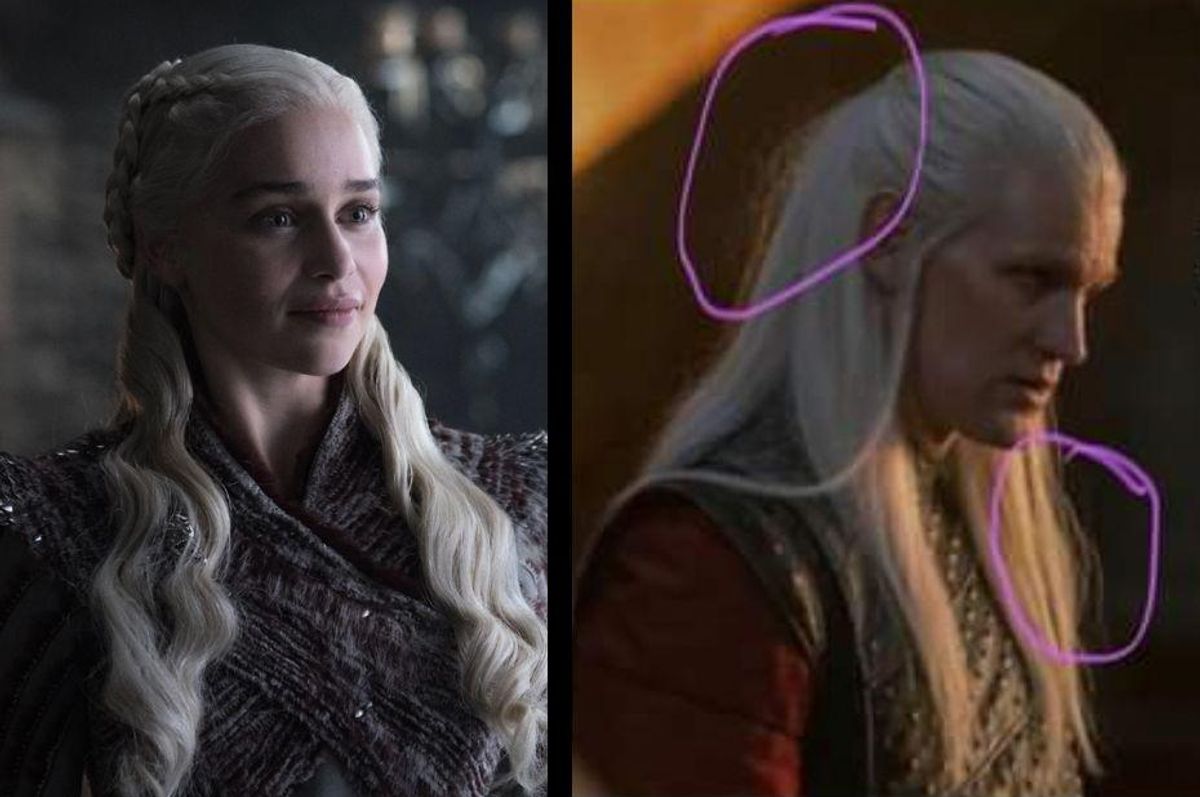Have you noticed your favorite shows don't look as good as they used to? This viral post explains why.
A fascinating look at quality versus quantity.

One of these things is not like the other.
For fantasy fans, it truly is the best of times, and the worst of times. On the bright side—there’s more magic wielding, dragon riding, caped crusading content than ever before. Yay to that. On the other hand, have you noticed that with all these shows, something feels…off?
And i don't just mean adulthood stripping you of childlike wonder. There is a subtle, yet undeniable decline in how these shows are being made, and your eyes are picking up on it. Nolan Yost, a freelance wigmaker living in New York City, explains the shift in his viral 2022 Facebook post.
The post, which has been shared nearly 3,500 times, attributes shows being “mid,” (aka mediocre, or my favorite—meh) mostly to the new streaming-based studio system, which quite literally prioritizes quantity over quality, pumping out new content as fast as possible to snag a huge fan base.
The result? A “Shein era of mass media,” Yost says, adding that “the toll it takes on costuming and hair/makeup has made almost every new release from Amazon, Netflix, and Hulu have a B-movie visual quality.”
He even had some pictures to prove it.
Yost first addressed the Amazon Prime Series The Rings of Power. One of the many, many things that makes Peter Jackson’s The Lord of the Rings trilogy so iconic is the costumes. But that legacy was the direct result of dedication to detail.
“The production spent years hand-making every single piece of armor with real metal, hand-dyeing all-natural fiber fabrics, and designing distinct embroidery and hairstyles specific to each race in Middle Earth that had continuity through the story,” Yost wrote.
He added, “the natural dyes and dedicated layers of fabrics for elves, for hobbits, wool/dyes, and for men had a much more muted/medieval look, yet ethereal because of the slight detail you don’t really notice, but the depth draws your eye to every inch of the costume regardless.” This, he says, is why those three movies stand the test of time.
Compare this to the two images from The Rings of Power below. In one photo “they barely scrapped together an unnaturally gilded scale mail breastplate and just screen printed a stretched long sleeve shirt to match underneath, all over a skirt in a single layer of a warped poly skirt.”

Now you too can look like you're from Middle Earth for the low, low cost of $10.99.
The other image shows “they just saved money on an Elven wig altogether for a 2022 pompadour, with a velvet pleated priest smock (with crushed parts not even steamed out), and a neckline that isn’t tailored to fit like we’ve seen previously with Elrond or Celeborn.”
Yost then moved onto HBO’s House of the Dragon. Arguably even those who have never seen a single episode of its predecessor, Game of Thrones, would still recognize Daenerys Targaryen for her platinum white hair—an attribute that Yost notes was quite expensive.

It cost big bucks to be a Khalessi.
GiphyHe explained that for the show’s final season alone, Daenerys’ wigs most likely cost tens of thousands, requiring human hair to be custom made into multiple wigs.
Luckily, there was only one character with that signature look in the show. For House of the Dragon, however, with a cast almost entirely made up of silver-haired brooding powerhouses, Yost surmises that due to budget constraints, the creators opted for synthetic wigs.
You can see below the problem this cost-cutting decision makes in terms of authenticity.

Luckily, Matt Smith is such a good actor a few stray hairs are an easily forgivable.
“Synthetic hair reflects light throughout the whole hair shaft and it tangles extremely easily,” Yost writes. “With any shot where a character isn’t actively moving or is performing dialogue and the hair isn’t being actively smoothed down every couple of seconds between shots, each flyaway is going to show up on camera if there’s any indirect lighting and look messy. Not only that, synthetic hair is also twice as thick per strand than human hair, so regardless of that the wigs are going to look bulky in an uncanny valley sort of way.”
This affects not just sci-fi and fantasy, but other genres meant to transport viewers into other worlds, like period pieces, which Yost points out with a picture from Bridgerton by Shonda Rhimes.

Yeah, this does look like they're wearing curtains. And not in a fun "Sound of Music" kind of way.
“It’s obviously not meant to be historically accurate, which is totally fine,” he writes, but without important details or embellishments or even proper undergarments to make the clothes fit well, everything looks like a slightly more expensive Halloween costume.
Yost’s insightful post really shines a light on what audiences are having to trade off for the sake of constant output. The phrase “done is better than perfect” takes on a new meaning altogether as studios race to meet a deadline with whatever is easiest to mass produce. But if viewers are so easily taken out of these stories because of noticeable corner cutting, then perhaps it’s a sign that what we really want and need are stories worth waiting for, ones that truly pull us in and leave us captivated. This is no easy ask, for studio execs or customers alike (I too am a voracious binge-watcher), but as we can see in these examples, the most valuable experiences rarely, if ever, come from rushing.
This article originally appeared three years ago.

